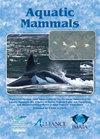纽约湾大型鲸鱼社会性行为的证据
IF 0.8
4区 生物学
Q4 MARINE & FRESHWATER BIOLOGY
引用次数: 0
摘要
大型鲸鱼,包括濒临灭绝的塞鲸(Balaenoptera borealis),抹香鲸(Physeter macrocephalus)和北大西洋露脊鲸(Eubalaena glacialis),已知出现在纽约湾。然而,关于该地区这些物种典型的社会行为的数据相对较少。美国大西洋中部历来被认为是鲸鱼迁徙的大走廊,很少有调查记录鲸鱼在这些水域的社会动态。为了更好地了解这些物种的发生、分布、丰度和行为,以便进行管理和保护规划,在2017年3月至2020年2月的3年期间,每月进行样线航空调查。在这些调查中,在塞鲸(2019年4月)、抹香鲸(2019年9月)和露脊鲸(2019年12月)群体中观察并拍摄了三个值得注意的社会性行为事件。事件包括非生殖性行为(社会性行为)或同种动物之间的性行为(交配),包括镜像配对游泳,横向和垂直呈现,以及腹部对腹部接触。在这三个事件中,群体在水面上高度活跃,频繁而快速地改变速度和方向,并且动物与群体中其他同类动物的距离主要小于一个体长。所有物种在水面或接近水面时都被记录到侧身和/或背部翻滚。张口表演发生在北大西洋露脊鲸事件中。虽然在抹香鲸事件中不太可能发生交配,而且由于同性个体的识别,在露脊鲸事件中也不可能发生交配,但不能排除它是塞鲸事件的推动力。这些观察结果开始描述纽约湾的相对重要性不仅仅是一个迁徙走廊,并建议将更多的以行为为重点的数据收集纳入未来的调查。本文章由计算机程序翻译,如有差异,请以英文原文为准。
Evidence of Large Whale Socio-Sexual Behavior in the New York Bight
Large whales, including the endangered sei whale (Balaenoptera borealis), sperm whale (Physeter macrocephalus), and North Atlantic right whale (Eubalaena glacialis), are known to occur in the New York Bight. However, relatively little data exist on social behavior typical of these species in the area. The U.S. Mid-Atlantic has traditionally been considered a large whale migratory corridor with few surveys documenting social dynamics of whale presence in these waters. To better understand the occurrence, distribution, abundance, and behavior of these species for management and conservation planning, monthly line-transect aerial surveys were conducted over a 3-year period from March 2017 to February 2020. During these surveys, three noteworthy socio-sexual behavior events were observed and photographed within groups of sei whales (April 2019), sperm whales (September 2019), and right whales (December 2019). Events included what could be either non-reproductive sexual behavior (socio-sexual behavior) or sexual behavior (copulation) among conspecifics, including mirror pair swimming, lateral and vertical presenting, and belly to belly contact. During all three events, groups were highly active at the surface, frequently and quickly changing speed and direction, and animals were predominantly less than one body length apart from other conspecifics in the group. All species were recorded rolling onto their sides and/or back while at or near the surface. Open mouth display occurred in the North Atlantic right whale event. Though copulation is unlikely to have transpired during the sperm whale event and could not have occurred during the right whale event due to the identification of same-sex individuals, it cannot be ruled out as the impetus for the sei whale event. These observations begin to describe the relative importance of the New York Bight as more than a migratory corridor and suggest that additional behaviorally focused data collection be incorporated into future surveys.
求助全文
通过发布文献求助,成功后即可免费获取论文全文。
去求助
来源期刊

Aquatic Mammals
MARINE & FRESHWATER BIOLOGY-ZOOLOGY
CiteScore
1.60
自引率
16.70%
发文量
99
审稿时长
>12 weeks
期刊介绍:
Aquatic Mammals is a peer-reviewed journal sponsored by the European Association for Aquatic Mammals (EAAM), the Alliance of Marine Mammal Parks and Aquariums (AMMPA), and the International Marine Animal Trainers’ Association (IMATA). Aquatic Mammals publishes articles related to marine mammals (whales, dolphins, seals, fur seals, sea lions, walrus, dugongs, manatees, sea otters, and polar bears). Topics of publication on both captive animals and wild marine mammals include aspects of husbandry; behavior; conservation; veterinary medicine; anatomy; physiology; training; population trends; and the effects of pollution, climate change, and noise.
 求助内容:
求助内容: 应助结果提醒方式:
应助结果提醒方式:


